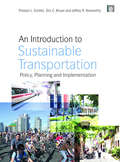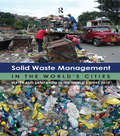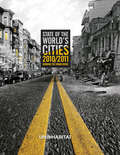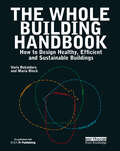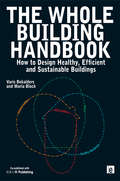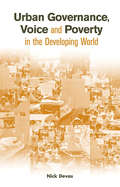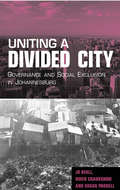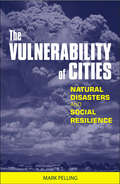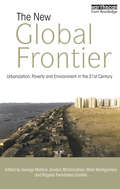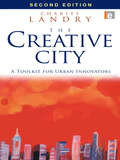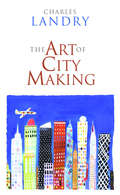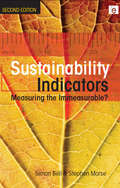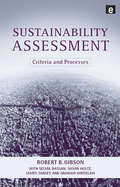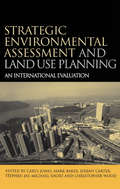- Table View
- List View
An Introduction to Sustainable Transportation: Policy, Planning and Implementation
by Preston L. Schiller Jeffrey R. KenworthyTransportation plays a substantial role in the modern world; it provides tremendous benefits to society, but it also imposes significant economic, social and environmental costs. Sustainable transport planning requires integrating environmental, social, and economic factors in order to develop optimal solutions to our many pressing issues, especially carbon emissions and climate change. This essential multi-authored work reflects a new sustainable transportation planning paradigm. It explores the concepts of sustainable development and sustainable transportation, describes practical techniques for comprehensive evaluation, provides tools for multi-modal transport planning, and presents innovative mobility management solutions to transportation problems. Students of various disciplines, planners, policymakers and concerned citizens will find many of its provocative ideas and approaches of considerable value as they engage in the processes of understanding and changing transportation towards greater sustainability. This text reflects a fundamental change in transportation decision making. It focuses on accessibility rather than mobility, emphasizes the need to expand the range of options and impacts considered in analysis, and provides practical tools to allow planners, policy makers and the general public to determine the best solution to the transportation problems facing a community. The book starts by placing transportation within the broader sustainability discussion, emphasising a comprehensive approach to sustainability planning and introducing the notion of 'regenerative transportation'. In sections on policymaking and planning the book examines how decisions are currently, and how they should be, made - explaining the complex and often misunderstood area of public participation. The authors explain demand management as applied to transportation and present lessons from other public arenas and areas of application, especially in urban-suburban areas. The text takes readers through each and every mode of transport, beginning with human-powered modes and ending in motorized modes, including marine and air transport. The modes are analyzed separately and in comparison with others according to several criteria: Capacity/utility/functionality considerations; infrastructure demands; resource consumption; land use considerations; pollution; and costs. In ways that non-technically trained readers as well as planning students professionals can find useful the book includes guidance on how to optimize transportation systems; balancing economic, social and environmental objectives while creating just, robust, and diverse, rather than one-size-fits-all, solutions. The modes are grouped and compared within their respective contexts, and there is vital discussion and differentiation between passenger and freight-goods transport. The final section develops a comprehensive summary of the previous chapters and develops arguments for sustainable transportation policymaking and integrated planning, providing international examples and case studies and extracting from them general applications for integrated sustainable transportation. Featuring extensive international examples and case-studies, textboxes, graphics, recommended reading and end of chapter questions, the authors draw on considerable teaching and researching experience to present an essential, ground-breaking and authoritative text on sustainable transport.
An Introduction to Sustainable Transportation: Policy, Planning and Implementation
by Preston L. Schiller Jeffrey R. KenworthyTransportation plays a substantial role in the modern world; it provides tremendous benefits to society, but it also imposes significant economic, social and environmental costs. Sustainable transport planning requires integrating environmental, social, and economic factors in order to develop optimal solutions to our many pressing issues, especially carbon emissions and climate change. This essential multi-authored work reflects a new sustainable transportation planning paradigm. It explores the concepts of sustainable development and sustainable transportation, describes practical techniques for comprehensive evaluation, provides tools for multi-modal transport planning, and presents innovative mobility management solutions to transportation problems. Students of various disciplines, planners, policymakers and concerned citizens will find many of its provocative ideas and approaches of considerable value as they engage in the processes of understanding and changing transportation towards greater sustainability. This text reflects a fundamental change in transportation decision making. It focuses on accessibility rather than mobility, emphasizes the need to expand the range of options and impacts considered in analysis, and provides practical tools to allow planners, policy makers and the general public to determine the best solution to the transportation problems facing a community. The book starts by placing transportation within the broader sustainability discussion, emphasising a comprehensive approach to sustainability planning and introducing the notion of 'regenerative transportation'. In sections on policymaking and planning the book examines how decisions are currently, and how they should be, made - explaining the complex and often misunderstood area of public participation. The authors explain demand management as applied to transportation and present lessons from other public arenas and areas of application, especially in urban-suburban areas. The text takes readers through each and every mode of transport, beginning with human-powered modes and ending in motorized modes, including marine and air transport. The modes are analyzed separately and in comparison with others according to several criteria: Capacity/utility/functionality considerations; infrastructure demands; resource consumption; land use considerations; pollution; and costs. In ways that non-technically trained readers as well as planning students professionals can find useful the book includes guidance on how to optimize transportation systems; balancing economic, social and environmental objectives while creating just, robust, and diverse, rather than one-size-fits-all, solutions. The modes are grouped and compared within their respective contexts, and there is vital discussion and differentiation between passenger and freight-goods transport. The final section develops a comprehensive summary of the previous chapters and develops arguments for sustainable transportation policymaking and integrated planning, providing international examples and case studies and extracting from them general applications for integrated sustainable transportation. Featuring extensive international examples and case-studies, textboxes, graphics, recommended reading and end of chapter questions, the authors draw on considerable teaching and researching experience to present an essential, ground-breaking and authoritative text on sustainable transport.
Solid Waste Management in the World's Cities: Water and Sanitation in the World's Cities 2010
by Un-HabitatIn our rapidly urbanizing global society, solid waste management will be a key challenge facing all the world's cities. Solid Waste Management in the World's Cities provides a fresh perspective and new data on one of the biggest issues in urban development. Using the framework of Integrated Sustainable Waste Management (ISWM), the report brings together unprecedented research from 22 cities across six continents. It uncovers the rich diversity of waste management systems that are in place throughout the world, and draws out the practical lessons for policymakers. The volume will be essential reading for all professionals and policymakers in the field, as well as a valuable resource for researchers and students in all aspects of urban development. Winner of the International Solid Waste Association Publication Award 2010 Published with UN-Habitat.
Solid Waste Management in the World's Cities: Water and Sanitation in the World's Cities 2010
by Un-HabitatIn our rapidly urbanizing global society, solid waste management will be a key challenge facing all the world's cities. Solid Waste Management in the World's Cities provides a fresh perspective and new data on one of the biggest issues in urban development. Using the framework of Integrated Sustainable Waste Management (ISWM), the report brings together unprecedented research from 22 cities across six continents. It uncovers the rich diversity of waste management systems that are in place throughout the world, and draws out the practical lessons for policymakers. The volume will be essential reading for all professionals and policymakers in the field, as well as a valuable resource for researchers and students in all aspects of urban development. Winner of the International Solid Waste Association Publication Award 2010 Published with UN-Habitat.
State of the World's Cities 2010/11: Bridging the Urban Divide
by Un-HabitatThe world's urban population now exceeds the world's rural population. What does this mean for the state of our cities, given the strain this global demographic shift is placing upon current urban infrastructures? Following on from previous State of the World's Cities reports, this edition uses the framework of 'The Urban Divide' to analyse the complex social, political, economic and cultural dynamics of urban environments. In particular, the book focuses on the concept of the 'right to the city' and ways in which many urban dwellers are excluded from the advantages of city life, using the framework to explore links among poverty, inequality, slum formation and economic growth. The volume will be essential reading for all professionals and policymakers in the field, as well as a valuable resource for researchers and students in all aspects of urban development. Published with UN-Habitat.
State of the World's Cities 2010/11: Bridging the Urban Divide
by Un-HabitatThe world's urban population now exceeds the world's rural population. What does this mean for the state of our cities, given the strain this global demographic shift is placing upon current urban infrastructures? Following on from previous State of the World's Cities reports, this edition uses the framework of 'The Urban Divide' to analyse the complex social, political, economic and cultural dynamics of urban environments. In particular, the book focuses on the concept of the 'right to the city' and ways in which many urban dwellers are excluded from the advantages of city life, using the framework to explore links among poverty, inequality, slum formation and economic growth. The volume will be essential reading for all professionals and policymakers in the field, as well as a valuable resource for researchers and students in all aspects of urban development. Published with UN-Habitat.
The Whole Building Handbook: "How to Design Healthy, Efficient and Sustainable Buildings"
by Maria Block Varis BokaldersThe Whole Building Handbook is a compendium of all the issues and strategies that architects need to understand to design and construct sustainable buildings for a sustainable society. The authors move beyond the current definition of sustainability in architecture, which tends to focus on energy-efficiency, to include guidance for architecture that promotes social cohesion, personal health, renewable energy sources, water and waste recycling systems, permaculture, energy conservation - and crucially, buildings in relation to their place. The authors offer a holistic approach to sustainable architecture and authoritative technical advice, on: * How to design and construct healthy buildings, through choosing suitable materials, healthy service systems, and designing a healthy and comfortable indoor climate, including solutions for avoiding problems with moisture, radon and noise as well as how to facilitate cleaning and maintenance. * How to design and construct buildings that use resources efficiently, where heating and cooling needs and electricity use is minimized and water-saving technologies and garbage recycling technologies are used. * How to 'close' organic waste, sewage, heat and energy cycles. For example, how to design a sewage system that recycles nutrients. * Includes a section on adaptation of buildings to local conditions, looking at how a site must be studied with respect to nature, climate and community structure as well as human activities. The result is a comprehensive, thoroughly illustrated and carefully structured textbook and reference.
The Whole Building Handbook: "How to Design Healthy, Efficient and Sustainable Buildings"
by Maria Block Varis BokaldersThe Whole Building Handbook is a compendium of all the issues and strategies that architects need to understand to design and construct sustainable buildings for a sustainable society. The authors move beyond the current definition of sustainability in architecture, which tends to focus on energy-efficiency, to include guidance for architecture that promotes social cohesion, personal health, renewable energy sources, water and waste recycling systems, permaculture, energy conservation - and crucially, buildings in relation to their place. The authors offer a holistic approach to sustainable architecture and authoritative technical advice, on: * How to design and construct healthy buildings, through choosing suitable materials, healthy service systems, and designing a healthy and comfortable indoor climate, including solutions for avoiding problems with moisture, radon and noise as well as how to facilitate cleaning and maintenance. * How to design and construct buildings that use resources efficiently, where heating and cooling needs and electricity use is minimized and water-saving technologies and garbage recycling technologies are used. * How to 'close' organic waste, sewage, heat and energy cycles. For example, how to design a sewage system that recycles nutrients. * Includes a section on adaptation of buildings to local conditions, looking at how a site must be studied with respect to nature, climate and community structure as well as human activities. The result is a comprehensive, thoroughly illustrated and carefully structured textbook and reference.
Urban Governance Voice and Poverty in the Developing World
by Nick DevasPoverty and governance are both issues high on the agenda of international agencies and governments in the South. With urban areas accounting for a steadily growing share of the world's poor people, an international team of researchers focused their attention on the hitherto little-studied relationship between urban governance and urban poverty. In their timely and in-depth examination of ten cities in Africa, Asia and Latin America, they demonstrate that in many countries the global trends towards decentralization and democratization offer new opportunities for the poor to have an influence on the decisions that affect them. They also show how that influence depends on the nature of those democratic arrangements and decision-making processes at the local level, as well as on the ability of the poor to organize. The study involved interviews with key actors within and outside city governments, discussions with poverty groups, community organizations and non-governmental organizations (NGOs), as well as analyses of data on poverty, services and finance. This book presents insights, conclusions and practical examples that are of relevance for other cities. It outlines policy implications for national and local governments, NGOs and donor agencies, and highlights ways in which poor people can use their voice to influence the various institutions of city governance.
Urban Governance Voice and Poverty in the Developing World
by Nick DevasPoverty and governance are both issues high on the agenda of international agencies and governments in the South. With urban areas accounting for a steadily growing share of the world's poor people, an international team of researchers focused their attention on the hitherto little-studied relationship between urban governance and urban poverty. In their timely and in-depth examination of ten cities in Africa, Asia and Latin America, they demonstrate that in many countries the global trends towards decentralization and democratization offer new opportunities for the poor to have an influence on the decisions that affect them. They also show how that influence depends on the nature of those democratic arrangements and decision-making processes at the local level, as well as on the ability of the poor to organize. The study involved interviews with key actors within and outside city governments, discussions with poverty groups, community organizations and non-governmental organizations (NGOs), as well as analyses of data on poverty, services and finance. This book presents insights, conclusions and practical examples that are of relevance for other cities. It outlines policy implications for national and local governments, NGOs and donor agencies, and highlights ways in which poor people can use their voice to influence the various institutions of city governance.
Uniting a Divided City: Governance and Social Exclusion in Johannesburg
by Jo Beall Owen Crankshaw Susan ParnellFor many, Johannesburg resembles the imagined spectre of the urban future. Global anxieties about catastrophic urban explosion, social fracture, environmental degradation, escalating crime and violence, and rampant consumerism alongside grinding poverty, are projected onto this city as a microcosm of things to come. Decision-makers in cities worldwide have attempted to balance harsh fiscal and administrative realities with growing demands for political, economic and social justice. This book investigates pragmatic approaches to urban economic development, service delivery, spatial restructuring, environmental sustainability and institutional reform in Johannesburg. It explores the conditions and processes that are determining the city's transformation into a cosmopolitan metropole and magnet for the continent.
Uniting a Divided City: Governance and Social Exclusion in Johannesburg
by Jo Beall Owen Crankshaw Susan ParnellFor many, Johannesburg resembles the imagined spectre of the urban future. Global anxieties about catastrophic urban explosion, social fracture, environmental degradation, escalating crime and violence, and rampant consumerism alongside grinding poverty, are projected onto this city as a microcosm of things to come. Decision-makers in cities worldwide have attempted to balance harsh fiscal and administrative realities with growing demands for political, economic and social justice. This book investigates pragmatic approaches to urban economic development, service delivery, spatial restructuring, environmental sustainability and institutional reform in Johannesburg. It explores the conditions and processes that are determining the city's transformation into a cosmopolitan metropole and magnet for the continent.
The Vulnerability of Cities: Natural Disasters and Social Resilience
by Mark PellingWhen disaster strikes in cities the effects can be catastrophic compared to other environments. But what factors actually determine the vulnerability or resilience of cities? The Vulnerability of Cities fills a vital gap in disaster studies by examining the too-often overlooked impact of disasters on cities, the conditions leading to high losses from urban disasters and why some households and communities withstand disaster more effectively than others. Mark Pelling takes a fresh look at the literature on disasters and urbanization in light of recent catastrophes. He presents three detailed studies of cities in the global South, drawn from countries with contrasting political and developmental contexts: Bridgetown, Barbados - a liberal democracy; Georgetown, Guyana - a post socialist-state; and Santo Domingo, Dominican Republic - an authoritarian state in democratic transition. This book demonstrates that strengthening local capacity - through appropriate housing, disaster-preparedness, infrastructure and livelihoods - is crucial to improving civic resilience to disasters. Equally important are strong partnerships between local community-based organizations, external non-governmental and governmental organizations, public and private sectors and between city and national government. The author highlights and discusses these best practices for handling urban disasters. With rapid urbanization across the globe, this book is a must-read for professionals, policy-makers, students and researchers in disaster management, urban development and planning, transport planning, architecture, social studies and earth sciences.
The New Global Frontier: Urbanization, Poverty and Environment in the 21st Century
by George Martine Gordon McGranahan Mark Montgomery Rogelio Fernandez-CastillaThe world?s developing countries will be experiencing massive increases in their urban populations over the 21st century. If managed intelligently and humanely, this growth can pave the way to sustainable development; otherwise, it will favour higher levels of poverty and environmental stress. The outcome depends on decisions being made now. The principal theme that runs through this volume is the need to transform urbanization into a positive force for development. Part I of this book reviews the demography of the urban transition, stressing the importance of benefi cial rural-urban connections and challenging commonly held misconceptions. Part II asks how urban housing, land and service provision can be improved in the face of rapid urban expansion, drawing lessons from experiences around the world. Part III analyses the challenges and opportunities that urbanization presents for improving living environments and reducing pressures on local and global ecosystems. These social and environmental challenges must be met in the context of fast-changing demographic circumstances; Part IV explores the range of opportunities that these transformations represent. These challenges and opportunities vary greatly across Africa, Asia and Latin America, as detailed in Part V. Published with IIED and UNFPA
The New Global Frontier: Urbanization, Poverty and Environment in the 21st Century
by George Martine Gordon McGranahan Mark Montgomery Rogelio Fernandez-CastillaThe world?s developing countries will be experiencing massive increases in their urban populations over the 21st century. If managed intelligently and humanely, this growth can pave the way to sustainable development; otherwise, it will favour higher levels of poverty and environmental stress. The outcome depends on decisions being made now. The principal theme that runs through this volume is the need to transform urbanization into a positive force for development. Part I of this book reviews the demography of the urban transition, stressing the importance of benefi cial rural-urban connections and challenging commonly held misconceptions. Part II asks how urban housing, land and service provision can be improved in the face of rapid urban expansion, drawing lessons from experiences around the world. Part III analyses the challenges and opportunities that urbanization presents for improving living environments and reducing pressures on local and global ecosystems. These social and environmental challenges must be met in the context of fast-changing demographic circumstances; Part IV explores the range of opportunities that these transformations represent. These challenges and opportunities vary greatly across Africa, Asia and Latin America, as detailed in Part V. Published with IIED and UNFPA
The Creative City: A Toolkit for Urban Innovators
by Charles LandryThe Creative City is a clarion call for imaginative action in developing and running urban life. It shows how to think, plan and act creatively in addressing urban issues, with remarkable examples of innovation and regeneration from around the world. This revised edition of Charles Landry's highly influential text has been updated with a new, extensive overview.
The Creative City: A Toolkit for Urban Innovators
by Charles LandryThe Creative City is a clarion call for imaginative action in developing and running urban life. It shows how to think, plan and act creatively in addressing urban issues, with remarkable examples of innovation and regeneration from around the world. This revised edition of Charles Landry's highly influential text has been updated with a new, extensive overview.
The Art of City Making
by Charles LandryCity-making is an art, not a formula. The skills required to re-enchant the city are far wider than the conventional ones like architecture, engineering and land-use planning. There is no simplistic, ten-point plan, but strong principles can help send good city-making on its way. The vision for 21st century cities must be to be the most imaginative cities for the world rather than in the world. This one change of word - from 'in' to 'for' - gives city-making an ethical foundation and value base. It helps cities become places of solidarity where the relations between the individual, the group, outsiders to the city and the planet are in better alignment. Following the widespread success of The Creative City, this new book, aided by international case studies, explains how to reassess urban potential so that cities can strengthen their identity and adapt to the changing global terms of trade and mass migration. It explores the deeper fault-lines, paradoxes and strategic dilemmas that make creating the 'good city' so difficult.
The Art of City Making
by Charles LandryCity-making is an art, not a formula. The skills required to re-enchant the city are far wider than the conventional ones like architecture, engineering and land-use planning. There is no simplistic, ten-point plan, but strong principles can help send good city-making on its way. The vision for 21st century cities must be to be the most imaginative cities for the world rather than in the world. This one change of word - from 'in' to 'for' - gives city-making an ethical foundation and value base. It helps cities become places of solidarity where the relations between the individual, the group, outsiders to the city and the planet are in better alignment. Following the widespread success of The Creative City, this new book, aided by international case studies, explains how to reassess urban potential so that cities can strengthen their identity and adapt to the changing global terms of trade and mass migration. It explores the deeper fault-lines, paradoxes and strategic dilemmas that make creating the 'good city' so difficult.
Sustainability Indicators: Measuring the Immeasurable?
by Simon Bell Stephen MorsePraise for the first edition: 'This book should be of interest to anyone interested in sustainable development, and especially sustainability indicators. Bell and Morse easily succeed in exposing the fundamental paradoxes of these concepts and, more importantly, they offer us a way forward. Readers ... will find their practical recommendations for those attempting to do sustainability analysis in the field most welcome, which is also the book's greatest strength.' Local Environment: The International Journal of Justice and Sustainability 'This book makes a valuable contribution to the theory and practice of using indicators for sustainability. It introduces systems ideas and a range of tools and techniques that have the potential to broaden and deepen our understanding of a whole range of complex situations. Well worth a closer look.' Christine Blackmore, Open University 'This is a book that explores new ways of thinking about how to measure sustainability... It offers stimulating food for thought for environmental educators and researchers.' Environmental Education Research 'This book tells me, as an SI 'practitioner', where I have been and why, and more importantly how I should be thinking in order to effectively present to and empower the local community in the years ahead.' David Ellis, Principal Pollution Monitoring Officer, Norwich City Council 'A practical guide to the development of sustainability indicators which offers a systemic and participative way to use them at local scale. Our preliminary results are highly positive and the approach is applicable in many contexts.' Elisabeth Coudert, Programme Officer Prospective and Regional Development, Blue Plan The groundbreaking first edition of Sustainability Indicators reviewed the development and value of sustainability indicators and discussed the advantage of taking a holistic and qualitative approach rather than focusing on strictly quantitative measures. In the new edition the authors bring the literature up to date and show that the basic requirement for a systemic approach is now well grounded in the evidence. They examine the origins and development of Systemic Sustainability Analysis (SSA) as a theoretical approach to sustainability which has been developed in practice in a number of countries on an array of projects since the first edition. They look at how SSA has evolved into the practical approaches of Systemic Prospective Sustainability Analysis (SPSA) and IMAGINE, and, in particular, how a wide range of participatory methodologies have been adopted over the years. They also provide an assessment of the strengths and weaknesses of projects that undertake work in the general field of sustainable development.
Sustainability Indicators: Measuring the Immeasurable?
by Simon Bell Stephen MorsePraise for the first edition: 'This book should be of interest to anyone interested in sustainable development, and especially sustainability indicators. Bell and Morse easily succeed in exposing the fundamental paradoxes of these concepts and, more importantly, they offer us a way forward. Readers ... will find their practical recommendations for those attempting to do sustainability analysis in the field most welcome, which is also the book's greatest strength.' Local Environment: The International Journal of Justice and Sustainability 'This book makes a valuable contribution to the theory and practice of using indicators for sustainability. It introduces systems ideas and a range of tools and techniques that have the potential to broaden and deepen our understanding of a whole range of complex situations. Well worth a closer look.' Christine Blackmore, Open University 'This is a book that explores new ways of thinking about how to measure sustainability... It offers stimulating food for thought for environmental educators and researchers.' Environmental Education Research 'This book tells me, as an SI 'practitioner', where I have been and why, and more importantly how I should be thinking in order to effectively present to and empower the local community in the years ahead.' David Ellis, Principal Pollution Monitoring Officer, Norwich City Council 'A practical guide to the development of sustainability indicators which offers a systemic and participative way to use them at local scale. Our preliminary results are highly positive and the approach is applicable in many contexts.' Elisabeth Coudert, Programme Officer Prospective and Regional Development, Blue Plan The groundbreaking first edition of Sustainability Indicators reviewed the development and value of sustainability indicators and discussed the advantage of taking a holistic and qualitative approach rather than focusing on strictly quantitative measures. In the new edition the authors bring the literature up to date and show that the basic requirement for a systemic approach is now well grounded in the evidence. They examine the origins and development of Systemic Sustainability Analysis (SSA) as a theoretical approach to sustainability which has been developed in practice in a number of countries on an array of projects since the first edition. They look at how SSA has evolved into the practical approaches of Systemic Prospective Sustainability Analysis (SPSA) and IMAGINE, and, in particular, how a wide range of participatory methodologies have been adopted over the years. They also provide an assessment of the strengths and weaknesses of projects that undertake work in the general field of sustainable development.
Sustainability Assessment: Criteria and Processes
by Bob Gibson Selma Hassan James TanseySustainability assessment is now emerging as a more transparent, comprehensive, integrated and far-sighted approach to decision making. Its basic demand is that all significant undertakings must make a positive contribution to sustainability. To apply this test, decision makers need criteria based on the core requirements of sustainability and the particularities of the context. As well, they need appropriately designed public processes; guidance on the weighing of alternatives, trade-offs and compromises; a supportive policy framework; suitable tools and inspiring examples. Drawing from transdisciplinary theory and practical case experience, the book addresses these matters and many of the surrounding controversies. While sustainability assessment must always be adjusted to particular circumstances, the generic approach set out in this book is applicable virtually anywhere.
Sustainability Assessment: Criteria and Processes
by Bob Gibson Selma Hassan James TanseySustainability assessment is now emerging as a more transparent, comprehensive, integrated and far-sighted approach to decision making. Its basic demand is that all significant undertakings must make a positive contribution to sustainability. To apply this test, decision makers need criteria based on the core requirements of sustainability and the particularities of the context. As well, they need appropriately designed public processes; guidance on the weighing of alternatives, trade-offs and compromises; a supportive policy framework; suitable tools and inspiring examples. Drawing from transdisciplinary theory and practical case experience, the book addresses these matters and many of the surrounding controversies. While sustainability assessment must always be adjusted to particular circumstances, the generic approach set out in this book is applicable virtually anywhere.
Strategic Environmental Assessment and Land Use Planning: An International Evaluation
by Michael Short Mark Baker Jeremy Carter Stephen Jay Carys Jones'A wonderfully international and up-to-date perspective on strategic environmental assessment of land use plans by leading experts in the field. Strategic Environmental Assessment and Land Use Planning covers not only how much such SEAs are carried out and in what context, but whether they are effective and why. It provides invaluable insights for practitioners and researchers in this rapidy evolving field' Riki Therivel, author of Strategic Environmental Assessment in Action Strategic Environmental Assessment and Land Use Planning provides an authoritative, international evaluation of the SEA of land use plans. The editors place the SEA of land use plans in context, and uniquely qualified contributors then evaluate systems in Canada, Denmark, Germany, Hong Kong, Hungary, Ireland, The Netherlands, New Zealand, Portugal, South Africa, Sweden, the United Kingdom, the United States and the World Bank. These chapters provide a description of the context in each country, a case study of the use of SEA in land use planning and an evaluation of each SEA system against a set of generic criteria specially designed to anlayse different aspects of SEA. The contributors critically review each SEA system, SEA process and SEA outcome, and conclude by summarizing their findings. The editors draw the various national perspectives together in a final chapter and derive widely applicable conclusions about SEA and land use planning. This book is a core text for all students in environmental assessment, land use planning, environmental science, environmental management, development studies, geography, landscape design and law and engineering. It is also essential reading for all governments and environmental regulators, academics, researchers and environmental and planning consultants worldwide who are involvedin SEA research, practice and training.
Strategic Environmental Assessment and Land Use Planning: An International Evaluation
by Michael Short Mark Baker Jeremy Carter Stephen Jay Carys Jones'A wonderfully international and up-to-date perspective on strategic environmental assessment of land use plans by leading experts in the field. Strategic Environmental Assessment and Land Use Planning covers not only how much such SEAs are carried out and in what context, but whether they are effective and why. It provides invaluable insights for practitioners and researchers in this rapidy evolving field' Riki Therivel, author of Strategic Environmental Assessment in Action Strategic Environmental Assessment and Land Use Planning provides an authoritative, international evaluation of the SEA of land use plans. The editors place the SEA of land use plans in context, and uniquely qualified contributors then evaluate systems in Canada, Denmark, Germany, Hong Kong, Hungary, Ireland, The Netherlands, New Zealand, Portugal, South Africa, Sweden, the United Kingdom, the United States and the World Bank. These chapters provide a description of the context in each country, a case study of the use of SEA in land use planning and an evaluation of each SEA system against a set of generic criteria specially designed to anlayse different aspects of SEA. The contributors critically review each SEA system, SEA process and SEA outcome, and conclude by summarizing their findings. The editors draw the various national perspectives together in a final chapter and derive widely applicable conclusions about SEA and land use planning. This book is a core text for all students in environmental assessment, land use planning, environmental science, environmental management, development studies, geography, landscape design and law and engineering. It is also essential reading for all governments and environmental regulators, academics, researchers and environmental and planning consultants worldwide who are involvedin SEA research, practice and training.
